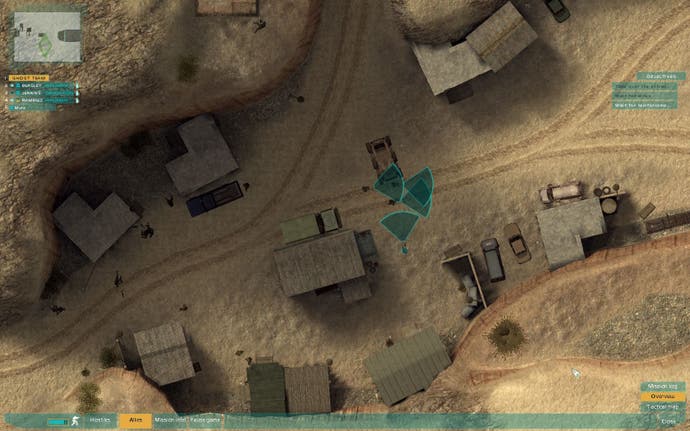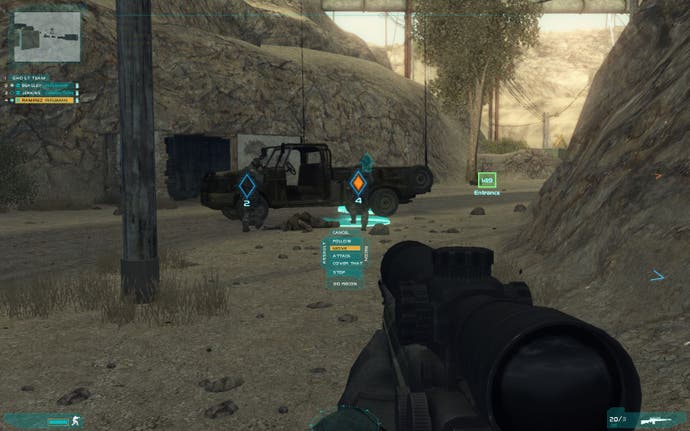Ghost Recon: Advanced Warfighter 2
Arthouse gaming redux. Snort.
"The sequel to the BAFTA award-winning Ghost Recon: Advanced Warfighter." Ooh, that still sounds a little weird, doesn't it?
GRAW The First's scooping of the trophy for game of the year from an institution that includes the word 'art' in its name is puzzling at best. It was certainly a tight and enjoyable team shooter built on bleeding-edge tech. But, y'know, it's a game I'd happily write words like "solid" and "intense" about, but probably not "creative" or "made me clap like an excited five-year-old given his first Kinder Egg." So, face flushed with pride, and with a small fortune in the bank, does GRAW's second coming strive to justify that trophy, and to take gaming to bold new places?
Oh, don't be an idiot. By its very nature, GRAW is not Peggle or Elebits or Crackdown. It's gaming almost as work, not play. This is a very serious business, focused solely on doing one thing as right as it can. And, lest you're confused why we're previewing a game already released, its impending PC build is a significantly different beast to its Xboxian incarnation.
Obviously, the move from over-the-shoulder cam to a solely FPS viewpoint bumps up the tactical side throughout, but specifically, it's more complicated and challenging on PC. The arcadeiness deemed necessary for the gamepad crowd has been made to go and stand in a corner, only really allowed to come out and play here on Easy mode, where poor accuracy and total lack of concern for team-mates won't mess things up too much.

GRAW 2 is harder and slower-going on PC, and the degree of control you're offered over your squad much deeper as a result. The top-down tactical map is almost a game in and of itself - you can queue up multiple commands and placements for one or all of your AI squadmates, in theory able to predict and shape a fight before it happens. This means a lot of the linearity is lost, each mission offering a bunch of different approaches to play our your complicated plans of death. Even the method by which you control your squad is optional - either through that map, with quick-click go/shoot/hide orders from your own perspective as squad leader, or whilst looking through the helmet-cam eyes of your men.
Whichever, it's war as maths, cold and complicated and harrowingly fast, and thus hugely appealing to a certain type of PC gamer. Brothers in Arms and Full Spectrum Warrior are the obvious comparisons, but with much more focus on directly and accurately shooting people in the face. That said, going on the three levels in the latest preview build, it's entirely possible to not get engaged in a fight yourself. If you're good enough at giving orders, your NPC buddies can do all the dirty work for you. Though if the AI of this build isn't improved come the final game, that's probably not something you should rely on, as having one of your men get stuck on a rock then stand up and wait for death isn't likely to up your chances of survival. Even if the AI does remain a bit ropey, clearly multiplayer, especially co-op, will be the true test of GRAW 2's mettle. It's a greater draw for many than the singleplayer campaign (which follows the same storyline as the 360 version, even if the interface and mission structure is a world away), but the online/LAN switch sadly hasn't been flipped in this preview build.

Regardless, the solo play changes mean GRAW 2 certainly feels like a game made specifically for the PC, closer almost to ArmA than to GRAW 1 (or GRAW 2 on 360). It's not the 360 game with bits on - it's very much its own entity. However the final game may turn out, this is a happy, happy precedent. Too many PC games have been artificially limited by the controls or smaller memory of consoles they're designed foremost for. If publishers are realising that PC and console aren't always kissing cousins, and more importantly perceive there to be a big enough pot of potential gold to make big changes worthwhile, that's a big old reason to be cheerful. Shout it from the rooftops -a publisher actually cares about PC enough to cook it its own meal, not just someone else's leftovers.
Special note, incidentally, must be made of GRAW 2's physics. With an Ageia PhysX card still in my rig as a hangover from writing 1000 words analysing the tech with unoptimistic conclusions, I was able to turn up the in-game physics settings to 'extreme' (possible without the card, but this will shoot the kneecaps off a game that's already a massive resource hog). As the lone game that makes it worthwhile, it's not enough to yet justify purchasing one of the cards for, but GRAW 2's use of PhysX is the most intelligent yet.
The lack of discretion I lamented in the PhysX piece was obviously also bothering someone with rather more industry clout than I, and it's great to see it addressed here. Swirling leaves in the air, trees and bushes (albeit somewhat cardboard cutouty ones) that sway in the wind, and plenty of destructible stuff - it's an impressive if incidental show, adding to the sense of world rather than just exaggerating explosions. It's first truly thoughtful implementation of PhysX's oft-promised but so rarely demonstrated potential. Not that it changes the game beyond visual bells and whistles, but it should make existing PhysX owners feel a little less slighted.

Of the game itself, the easy but valid criticism is that, while it's a smart and welcome re-tooling for a platform better-made for advanced warfighting, there's nothing in GRAW 2 likely to win it new fans. Unless there are some crazy setpieces or gadgetry in the final code, it's probably not gonna hugely excite you if you're not already enamoured of stony-faced tactical shooters about shooting terrorists. Its character exists entirely in the mechanics of controlling a squad, not in their personalities, the storyline or the art approach. It would certainly seem to be a game with a clear and well-realised purpose, but that purpose is not to further gaming. In other words, it's not a game likely to win, say, a BAFTA - but hey, stranger things have happened.


